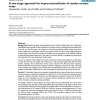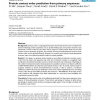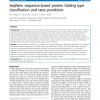262 search results - page 13 / 53 » Protein secondary structure prediction using neural networks |
BMCBI
2005
13 years 9 months ago
2005
Background: Secondary structure is used in hierarchical classification of protein structures, identification of protein features, such as helix caps and loops, for fold recognitio...
BMCBI
2006
13 years 9 months ago
2006
Background: Protein topology representations such as residue contact maps are an important intermediate step towards ab initio prediction of protein structure. Although improvemen...
JUCS
2010
13 years 7 months ago
2010
: When considering the prediction of a structural class for a protein as a classification problem, usually a classifier is based on a feature vector x ∈ Rn , where the features...
BMCBI
2008
13 years 9 months ago
2008
Background: Contact order is a topological descriptor that has been shown to be correlated with several interesting protein properties such as protein folding rates and protein tr...
BMCBI
2010
13 years 9 months ago
2010
Background: Protein folding rate is an important property of a protein. Predicting protein folding rate is useful for understanding protein folding process and guiding protein des...



